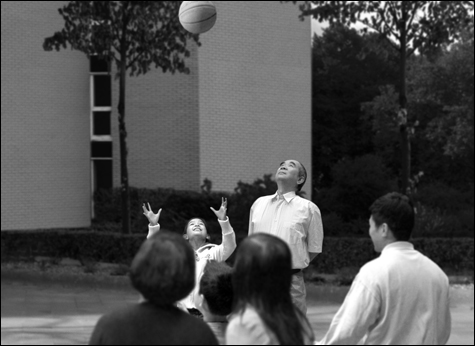
David Claerbout, Sections of a Happy Moment |
“David Claerbout” at List Visual Arts Center, 20 Ames St, Cambridge | February 8–April 6 | 617.253.4680
“Presumed Innocence” at DeCordova Museum, 51 Sandy Pond Road, Lincoln | February 2–April 27 | 781.259.8355
“Stage Idols, Japanese Kabuki Theater” at Peabody Essex Museum, East India Square, Salem | February 2–January 25 | 866.745.1876
“Pedacito De Cielo (1998-2008)” and“Correspondence” at Carpenter Center, 24 Quincy St, Cambridge | February 6–April 6 (“pedacito,” in the Sert Gallery) and February 6-16 (“Correspondence”) | 617.495.3251
“2008 Prc Student Exhibition” at Photographic Resource Center, 832 Comm Avenue, Boston | February 8–March 16 | 617.975.0600 |
We tend to take the passage of time for granted, reconciling such disparate experiences as 10 minutes spent rushing through lunch and 10 minutes spent waiting for a bus. Not to mention our sense of time in a film or a book, where a month may pass in a blink or a day take hundreds of pages to unfold. Opening at MIT’s List Visual Arts Center on February 8, “DAVID CLAERBOUT” surveys the work of a Belgian artist who has been exploring and cross-pollinating fixed and moving images since the mid 1990s. Working with digital and photographic techniques, Claerbout has developed what he calls a “moving still” — projected work that plays with our perceptions of time and space, inviting us to slow down to reconsider both narrative and “natural” tempos.Still photography brings time to a full stop, and photographs of children intensify our sense of a stolen moment — we cannot avoid the awareness that the subjects we are looking at have since gone on, changed, grown, left the scene. “PRESUMED INNOCENCE: PHOTOGRAPHIC PERSPECTIVES OF CHILDREN,” which opens at the DeCordova Museum on February 2, comprises 114 20th-century photographs selected for their dramatic and emotional impact, rather than in any attempt at an encyclopedic overview. Documentary and social photography mix with new digital technologies; photographers include Robert Frank, Loretta Lux, Ralph Eugene Meatyard, and Liu Zheng.
In 19th-century Japan, popular actors in the kabuki theater achieved rock-star status among their fans, and that provided ideal subject matter for Japanese print artists of the time. Opening at the Peabody Essex Museum on February 2, “STAGE IDOLS, JAPANESE KABUKI THEATER” presents more than 40 woodblock prints from the museum’s collection organized into three sections: “The Actors,” which looks at the careers of the stars; “The Plays,” with prints depicting scenes from performances; and “The Theater,” with period photographs, promotional plaques, and signboards.
I hate to go “laundry list” on my readers, but there’s so much to see these days. Do drop in on the two shows opening at Harvard’s Carpenter Center on February 6: “PEDACITO DE CIELO (1998-2008),” a project by Venezuelan artist Alessandro Balteo Yazbeck looking at architecture in Caracas in the 1950s–1970s, and “CORRESPONDENCE,” a student exhibition created in collaboration with students in Lahore, Pakistan, and Bremen, Germany, and featuring works that fit into a shoebox or an A4 envelope. And the “2008 PRC STUDENT SHOW” opens at the Photographic Resource Center on February 8, with new photos by artists from 17 PRC members’ schools in the Boston area.
On the Web
“David Claerbout”: http://web.mit.edu/lvac
“Presumed Innocence”: www.decordova.org
“Stage Idols, Japanese Kabuki Theater”: www.pem.org
“Pedacito De Cielo (1998-2008)” and “Correspondence”: www.ves.fas.harvard.edu/ccva.html
“2008 Prc Student Exhibition”: www.bu.edu/prc